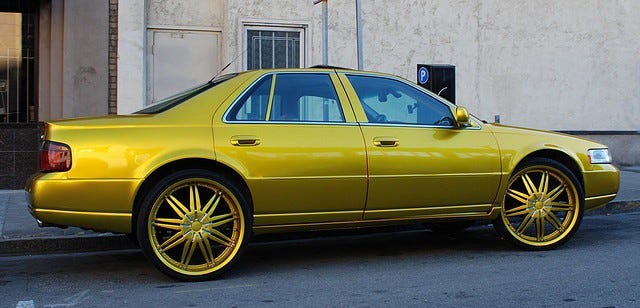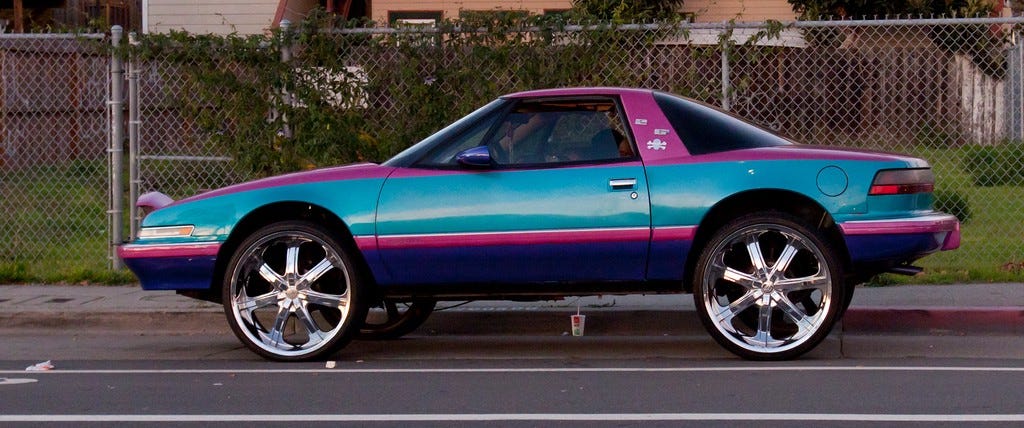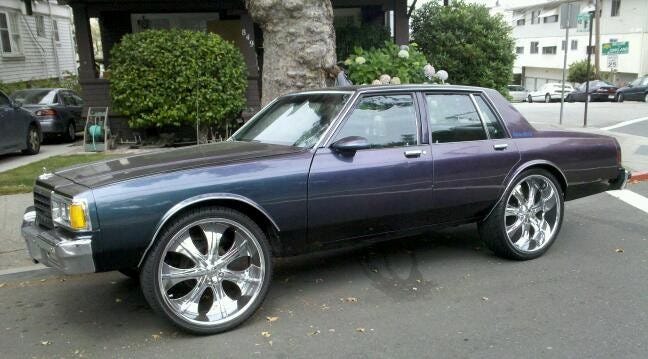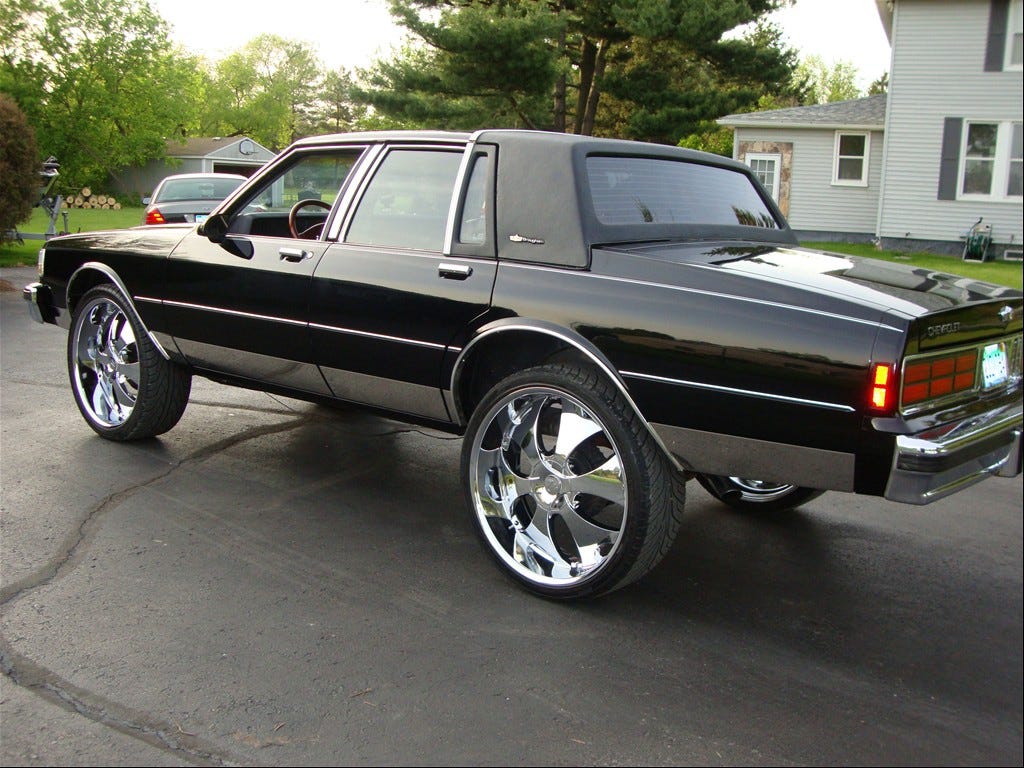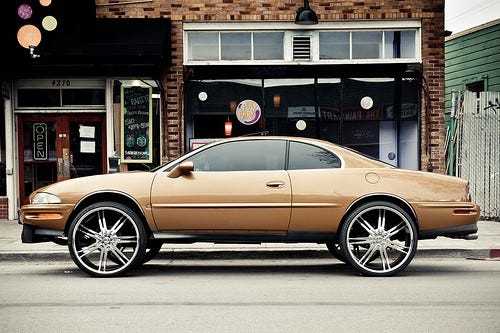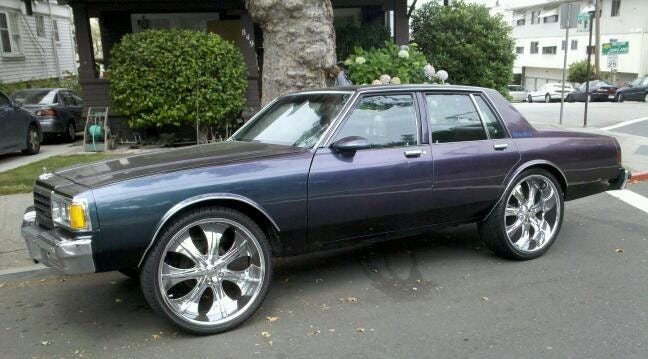In Conversation with Yakpasua Zazaboi (Field Bulletin USA Travel Club)
Q: In its most simplistic terms, what is a sideshow?
A: There’s two ways to describe a sideshow, you can either describe in what you see or you can go into what it means. There’s a lot of things going on at a sideshow. But at its core, what I’ve described it as in the past, it’s an expression of creativity.
What it was to East Oakland, it was like a free expression of creativity. And at the time that it started in the 80s, it was a result of… It was showing off, let me take that back, it’s exactly what’s in the name, it’s about showing off and that’s where the ‘show’ part of it came from. And side, the term side, came from the act of what we call siding. You pull up on somebody in your car, the car was an extension of your personality, it was part of your pride. And when you pulled up on somebody, you were proud of what you were rolling up in. So you’d be what is called siding on people. You pull up to the light and you’re looking at the person that’s pulled up next to you. It was like this real fun way of kinda showing off what you built, showing off what you had.
And the show part of it was, after the clubs got out or after any kinda event, you know it was a show of people siding. And people just started calling it the sideshow.
Q: And so you mentioned that it started in the 80s and from the research I’ve done, I’ve read that it started at the Eastmont Mall, but I’ve also read a different article that said it started at the Foothill Square. What’s the history of the sideshow?
A: There’s really not an accurate way to say that it started here or started there, because it’s something that developed. You know, it’s something that developed out of the culture. Just like so many other phenomenas that have happened, there isn’t one particular point in time that you can say that this started right here. What you’ll hear is how people remember, how they might have been exposed to the activity of siding. For some folks who were out there, steady out there in the beginnings, they’ll tell you that it even started back in the 70s.
But the most common definition and the most common historical representation would be from the 80s. Uh, Eastmont Mall at the time had a movie theater and a bunch of other stuff, so it was the place to hang out. Eastmont Mall was a busy mall.
Foothills Square, the same thing. If I remember correctly, Foothills Square had a rollerskating rink, so that was also the place to be. And rollerskating in Oakland used to be a real big thing.
So it was basically anywhere where there were a whole bunch of people gathered, when the event was over, it was like the main event started. So after parties, after clubs, after the rollerskating rink let out, after the movie theater let out, after a concert let out…you had people as their getting out, getting back into their cars and it was just an extension of them being themselves.
Q: What was your earliest memory of a sideshow?
A: So my first sideshow was 1996, and we were kids. And the funny part about it, we used to come to Oakland from San Francisco and the only thing we knew about Oakland was what was in Too Short’s raps. Back at that time, Too Short was kinda like one of the only people who’s music was really traveling into the areas that we lived at, across the Bay, even though it’s only across the bridge. We were more familiar with San Francisco artists than we were with Oakland artists. It was kinda like Too Short and there was this one album called Cell Block [Cell Block Compilation from Cell Block Records/Priority Records, 1996] that penetrated our listening habits out in San Francisco. So while we’re listening to Too Short, I think it’s a song called ‘Just Another Day’, and in the song he talks about coming down Seminary to the Foothills Strip or something. That was all we knew about Oakland.
And this is the thing that probably attracts everybody to the sideshow. It’s a group of people for the most part out to have fun. It’s in the middle of the night, it was just one of the most exciting things that I’ve ever seen. I was instantly hooked. And it’s pretty much the same experience that everybody has when they finally make it to an actual sideshow. You can see it on Instagram, you can see it on YouTube and the news, but there’s nothing quite like being out there…you feel so much at home, you know. And we weren’t even from out there, nobody cared. As long as we weren’t doing something to ruin the party, that was the last thing that anybody wanted to do was to ruin the party.
Q: So is it an East Oakland phenomenon? Did it start in East Oakland?
A: It definitely started in East Oakland. There’s no question about that. But it definitely spread.
Q: From my research, I saw a sideshow in Vallejo and even one on the Bay Bridge. Do sideshows happen in different parts of the Bay?
A: This kinda goes back to defining what a sideshow is. And we have to be conscious of what we’re calling a sideshow. And a lot of times people want the notoriety of being associated with a sideshow, when it’s really not by definition a sideshow. And the news is real famous for that. They would call everybody doing a donut in the middle of nowhere and associate it with a sideshow. In a sense, you criminalize an entire group of people who had nothing to do with whatever that one idiot was doing on a whole nother side of town, in a whole nother city.
Here’s something that I forgot to mention, at it’s core … at its very, very core, we went out to sideshows to try to attract women. That was it. That was why we put the chrome rims on the car, that’s why you put the paint on, that’s why you put the money into how you look because you were trying to attract some attention from some girls.
And if you’re a hundred dudes in the middle of the freeway doing damn donuts and there ain’t even no girls out there…what was the point. The girls came out because they were looking for the guys. You were peacocking. The flashier you were, the more attention you got. But you didn’t want to flip up and do something stupid.
And these days some of the stuff that people are calling a sideshow, really isn’t a sideshow. And it’s not necessarily their fault, it’s just that they were never exposed to what a sideshow actually was. They’re just so used to calling anything with a donut, a sideshow.
The sideshow, for the most part, when they first started, they were not about doing donuts at all. Donuts didn’t come into play in maybe the late 80s, early 90s, and it still wasn’t really the focus on attention.
Now by the end of the 90s, as muscle cars started more and more being produced again, people were kinda able to get an old school for relatively cheap, you start seeing a lot more high performance activities.
But Oakland was known for more of a classy style. And again, one of the more attention getting activities was the donuts. And so a lot of people, they just roll with donuts. But the donuts was, as some of the older cats will tell you, was something that you had to do because you didn’t have a car that was clean enough to get some attention. You got this guy next to you and he’s in an old school, candy paint, rims, his music…everything is real tight. He’s getting all the attention. How else you gonna pull the eyes off that car, except for starting to burn rubber and do something stupid? And that’s kinda how donuts started. It was more like, man that car ain’t worth shit, tear it up. It evolved.
Q: In terms of the modifications, the rims and candy paint…I continue to come across this term ‘scraper’. What is a ‘scraper’?
A: [chuckles] People they don’t even know the origins of scrapers. I don’t know if you’ll be able to get ahold of this guy, but there’s a guy named Marlo. He was infamous with this candy orange, box Chevy that he used to drive around all the time. I heard he still has it too. They’re from the 50s, the 5500 block to 5900 block area of East Oakland. They were the first people I ever heard call a vehicle a scrapper. But their definition of a scraper isn’t what people think it is.
There was a lot of activity, different activity, none of this was sideshow related at all…you had fellows that had the regular cars that they had, but they always had a little side car. You ever heard the term an underbucket? It was just a little side car that they didn’t care too much about. Some of these guys were making significant profit, their little buckets, you know the car that would normally be like a throwaway car was a little bit nicer than some people’s regular cars. And that is where the term scraper came from. The would just call it a little scraper, because they were scraping around town. But some of their side cars were pretty nice. It wasn’t like a beat up, old jalopy…they were looking for cars that were not noticeable. You know, you drove around the town in a candy painted, 1980s box Chevrolet, you were a target for the police. It didn’t matter, you were a target. They just gonna mess with you, give you a hard time, just because. These scrapers were about not being identified.
Q: Like a throw-off method.
A: Exactly. These were cars that people’s grandmother’s were driving around in. Let’s say these guys sold the car to one of the youngsters on the street. Well the youngster on the street is like I’m gonna put everything I can into this car. That’s how they started putting rims and stuff onto scrapers. But really it was just about being unnoticed. And people started putting rims and stuff on them, as now they were like the third owner of these cars.
Q: What about sideshows as marketplaces, in the sense of selling cassettes and CDs.
A: Yeah, it was definitely a marketplace. I was one of the first people to recognize that. When I did the first documentary on it, I was out there selling five minute tapes for five dollars. When I came out with a thirty minute version, I was selling it for damn near thirty dollars. It was a huge market. There was a lot of stuff going on, where people weren’t looking at it properly. Some people don’t know how to see things in different ways. I was one of the first people to recognize like here you have a group of people all out here having fun, in one location and the idea is everybody is trying to be seen and see each other, all in the same area at the same time then there’s all kinds of exchanges of ideas and products. People were out there selling their records, their albums, promoting parties. I was out there selling my videos of sideshows. And at the same time, I was out there promoting and organizing it as an event.
It was something back then that was common sense to us. Let’s organize this, let’s get some insurance and grow it as an event. I actually did one, in either 2006 or 2008, so many people showed up that we didn’t even have room to do donuts. But it was more of a proof of concept to show people that there’s a huge demand. You hear the news and politicians, they would constantly say that the draw of it was running from police. Here I am with an event to show people otherwise, it’s bullshit. Nobody wants to run from the damn police. They just want to have fun.
Q: You mentioned that they started in the 80s and your first exposure to it was in ’96, in the 80s was the music mostly mobb music? Did sideshows evolve with the music from mobb to hyphy?
A: The style of music had an affect on the whole entire generation. It wasn’t just sideshows. As people will tell you, in the 80s, most of us were listening to a lot of N.W.A. and as kids we internalized that shit. So whatever the music is, of course it’s going to affect the kids. In the 80s, I can’t speak for it, because I wasn’t out at sideshows, I don’t know what music was playing. But the sideshows were notoriously known for having hundreds of people dancing around their cars bumping Michael Jackson. You know, bumping S.O.S. [S.O.S. Band] and stuff like that. There was a lot of old school music playing too, it wasn’t like everybody just listening to rap. You heard a lot of 3X Krazy. When I started getting out there, one of the biggest artists in The Town was 3X Krazy. 3X Krazy, Tupac, The Luniz…but someone could just as easily pop in some Mtume. It was never you have to play this kind of music or not, it was all about whatever kinda mood you felt like you were in, that’s what you played. And if your shit sounded good, people were gonna be with you. You didn’t want to come out there and play some damn negative ass music and put everybody in a bad mood. You just heard stuff that sounded hella good, when there was a lot of people, your job was to try and get people dancing around your car.
Q: Do you think the sideshow is a distinctly Bay Area thing?
A: The event itself is distinctly East Oakland. Now the activities of sideshows aren’t anything new. Donuts have been around since probably horses and carriages. I’m sure somebody was doing some damn donuts in the snow in a horse and carriage. The way we branded the activities is something that is unique to East Oakland. And the way that East Oakland did it, people all over the world are trying to do it themselves as well. It’s infectious. People identify it as the coolest shit ever. You’re out there having fun and there’s not many places out here in Oakland where people can go and just have some fucking fun. Without having to wait in line for five hours to get into some damn club. Ain’t nothing going on, but drinking. To this day it’s one of those spaces where you can be as freely creative as you feel like it. That’s one of the things that we promote when speaking about sideshows and directing people to the positive aspects of it.
Q: What is gas-break-dip?
A: Dippin’. That was something that somebody said in a song and rebranded something that was already out here. Just called dippin’. Dippin’ was something that people were doing, if you had a car and your car wasn’t really, again it wasn’t all about doing donuts. So you were just coming out there showing off. A lot of these cars were nice, big, huge, metal made, old schools and people didn’t want to dog their shit out. Actually people would call it yiking. They were yiking. We’re no authority to what people can and can’t say. So people call stuff whatever they want to call it.
Q: In terms of your documentaries, how many sideshows did you document?
A: On the series itself, there’s three different volumes of it. As far as the content that I have, I would say hundreds. There’s hundreds of sideshows that I’ve documented. There’s still activity going on right now. If I were to add up all the content we have, I would say somewhere between three to five hundred sideshows. Maybe more.
Q: Out of all those, is there one or two that stand out as your favorite?
A: Yeah, two of them. One of them happened in a big ass parking lot, which used to be the Pack and Save, near the Coliseum. Shit, there were thousands of people out there. There were so many people, I had to get on top of an RV just to get a shot, so people could really see how many people were out there.
There was a dude on top of his car and he was just dancing on the roof. And it looked like he had fresh candy paint. He didn’t care. He just had the music up, and dancing on the roof and all of a sudden there were hundreds of people dancing around the car. It was just going down. No problems, nobody fighting, no police came for hours. It was just a really, really spectacular scene.
Another one, one of my favorites I would have to say was Cinco de Mayo 2001 or 2002. Havenscourt, Foothill. It had to easily be a thousand or two thousand people out there, broad daylight. People out there with children, it was just a really nice atmosphere.
I just want to clarify one thing too, the sideshow and the whole Hyphy movement were two different brands. Unfortunately, when stuff isn’t explained properly people like to jumble it all into one thing. And it makes it look like an entire culture is only about one type of thing. And the sideshows, at the time, didn’t know nothing about no Hyphy movement. But when Hyphy movement came out, people decided to try to…sideshows is the dancing it’s this, this, this, it’s everything. And it really wasn’t. And again when you start putting a blanket statement over a whole entire culture, it’s almost like not allowing somebody to have their own identity. And the sideshow really had its own identity. What you’re seeing nowadays is that identity being reclaimed again. You know what I’m saying. It’s a nice time for sideshows right now. We’re seeing it spread across the nation, L.A., Seattle, Detroit, New Orleans…all these folks are out there getting that sideshow vibe.







